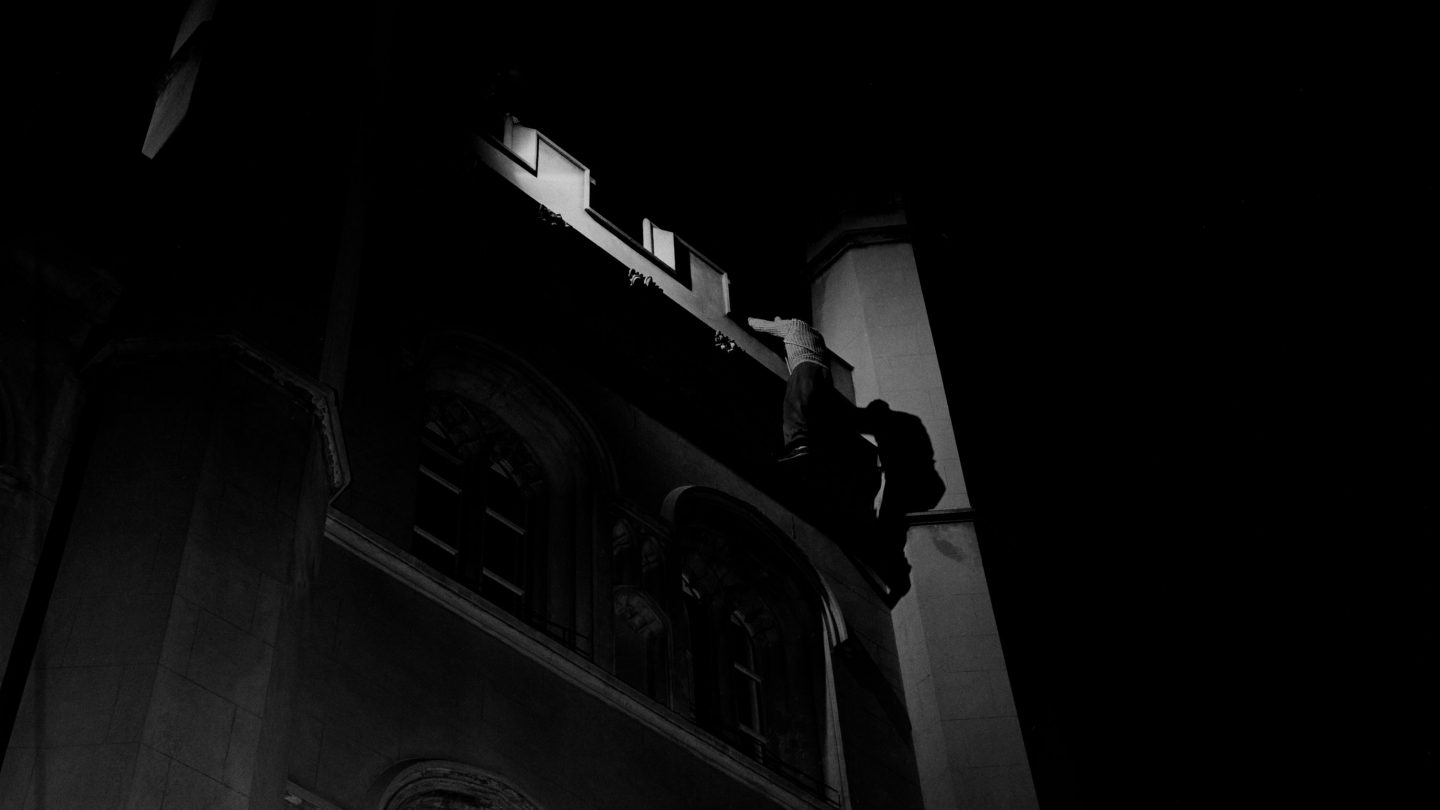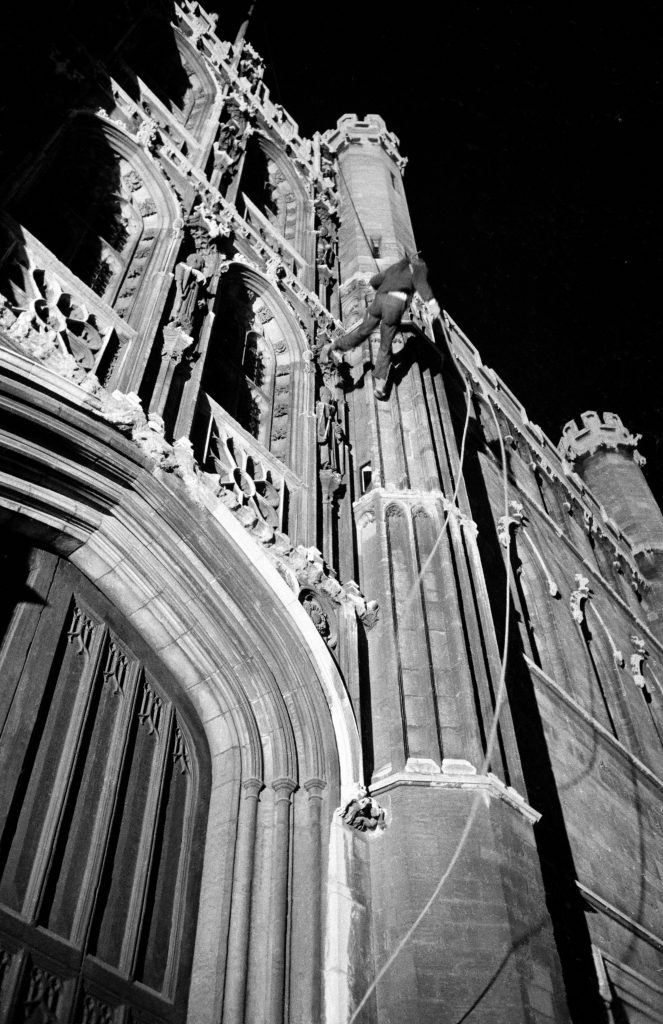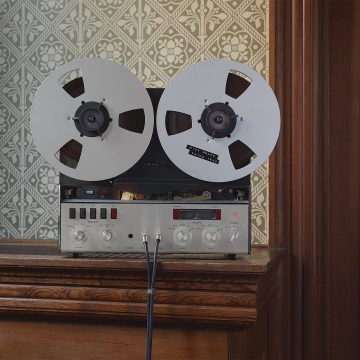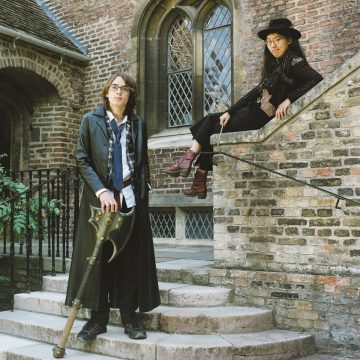
The truth about The Night Climbers of Cambridge
In 1937, The Night Climbers of Cambridge lifted the lid on a secret world of shadows. While not recommended, some say it is still going strong today.
Like so many good things, the idea took shape in the queue for a kebab and cheesy chips at the Van of Life in Market Square. “It was one of those ‘Hold my beer’ moments,” says Christian Preece (St Catharine’s 2010). “A friend from athletics thrust his food into my hand – three or four minutes later he appeared on the top of a roof four or five storeys up.”
Preece didn’t know it, but this was to be his initiation into a secret club dating back more than 100 years – the night-climbers of Cambridge. Joining his friend on the roof – “up the guttering, across one roof and a leg up over a two-metre wall before arriving on the flat roof above Five Guys on Market Street” – the experience was exhilarating. “It was quite a strange kind of sensation; like looking down on a Lowry painting,” says Preece.
Of course, night-climbing is not the type of activity you sign up for during freshers’ week. Perhaps you might hear subtle whispers, or maybe you come across a dog-eared copy of a slim volume entitled The Night Climbers of Cambridge, apparently by a mysterious figure calling himself Whipplesnaith.
The blanket of the dark hides each group of climbers from its neighbours. As furtively as the bats of twilight, they shun the eyes of the world
Whipplesnaith’s 1937 guidebook for the uninitiated reveals the hidden stairways to the spires, the jumps and pull-ups that can save grazed skin, and the essential kit to give the best chance of success. The author recognises he did not invent the “sport” – deferring instead to Geoffrey Winthrop Young’s 1901 tome The Roof Climber’s Guide to Trinity – but suggests the tradition may have evolved from the difficulty of getting back into college after the traditional 10pm curfew. Whipplesnaith’s is a nebulous world: “The blanket of the dark hides each group of climbers from its neighbours,” he writes. “As furtively as the bats of twilight, they shun the eyes of the world.”
The book’s pseudonymous author has since been unmasked as Noël Howard Symington (King’s 1932), but Tom Whipple (Churchill 2000) often ponders a possible family connection. “We always found the Whipple part a bit intriguing. My grandfather was there at the same time as Symington so it feels like an astonishing coincidence. There are intriguing pictures of other climbers in the book, but we can’t tell if it was him.”

Ascending one of the towers rising above Trinity New Court.
John Bulmer / Popperfoto / Getty
Whipple, now science editor of The Times, was initiated into the cult by his father, courtesy of a battered copy of Whipplesnaith’s book. The attraction of night-climbing to the younger Whipple was that it seemed impossibly romantic. “You feel like you are in some Evelyn Waugh novel. Who doesn’t want to imagine they are that sort of person?” he says.
Many others have been inspired to climb by the work of photographer John Bulmer (King’s 1957), who honed his art as a snapper for Varsity magazine while studying at King’s. Incredibly, Bulmer is terrified of heights and so many of his shots are taken from ground level, but others required him to follow the climbers up into the spires and slates. In June 1958, for example, Bulmer heard that a group of Caius engineering students had famously hoisted an Austin 7 van onto the roof of Senate House using cables and scaffolding ‘borrowed’ from King’s. His picture of the car on the rooftops taken the next morning is legendary among night-climbers.
You feel like you are in some Evelyn Waugh novel. Who doesn’t want to imagine they are that sort of person?
While a 2013 attempt to recreate this feat was thwarted by the authorities, a desire to put things on roofs has not diminished. Tom Whipple once took part in an expedition to hoist a wheelie bin onto the dome of New Hall that was dubbed the New Hall Nipple until it was removed. And as recently as last November, Santa hats have appeared overnight on the statues of St John’s College Chapel.
For others, there is a far more practical motivation for the climbs – a free pass into a May Ball, for example. According to Whipple: “There is a route into John’s where you start on a punt, climb up the Bridge of Sighs, onto a balcony, pause in the gap and then drop down. One year, we abseiled into Trinity with our climbing harnesses on under our dinner jackets and walked into the ball leaving the rope behind us,” he says. Whipple also recalls a route that gets you into St Catharine’s, but most colleges are now wise to the club’s activities – at King’s, security people are posted on routes.
And while Rebecca Wetten (Newnham 2011), who today works for the environmental charity Hubbub, didn’t make it into a ball without paying, she couldn’t resist the urge on the way back from one. “I was walking past the History Faculty on the way home with a friend. The Faculty building opens out like a book; it is high but pretty straightforward and so we climbed up and watched the sun rise,” she says.

Descending the Old Schools gatehouse, dropping down into Trinity Lane.
John Bulmer / Popperfoto / Getty
The routes to the roofs of Cambridge fall largely into three categories: ‘ladders’, ‘drainpipes’ and ‘chimneys’. Ladders – such as the recessed stone bands on the modern part of King’s on Trumpington Street – are popular starting points because beginners can scale them easily. The cast-iron drainpipes that punctuate the walls of the colleges, like so many exclamation marks, are also a good route up, although many are so firmly clamped to the walls that they offer no finger-room behind to gain a good grip. And ‘chimneys’ describe those ascents where the climber must put their back against one wall and feet against the other, exerting pressure with the legs to prevent slipping.
The Senate House Leap is considered to be night-climbing’s Everest challenge. Climbers ascend the south face of Caius using windowsills and bars and by leaning on the ‘stony celebrity’ to reach the roof. The jump across the passage is seven feet – at its narrowest. “When going from Caius to the Senate, it is about six inches down; jumping back is terrifying,” says John Bulmer.
It was one of those ‘Hold my beer’ moments. Three or four minutes later he appeared on the roof, four or five storeys up
Bulmer remembers getting caught by the police when trying to photograph someone attempting the Leap. “We were coming out of a play at the Arts Theatre when someone said, ‘We are thinking of taking a look at the Leap,’” he recalls. He popped to Varsity and picked up the last of the large flashbulbs that he used – no smartphones back then – before heading back to Senate House Passage. “He did the Leap but the flashbulb didn’t go off,” says Bulmer, still ruing the lack of proof.
“Moments later the police arrived. I hid behind a column but was discovered. The climber disappeared and hid under a bed in Caius. The porter searched but they never found him.” Meanwhile, Bulmer was hauled up before the Proctors. “I said I was just on my way home and by chance I had seen these people doing the Leap. They couldn’t pin anything on me.”
Getting caught scaling a college wall is thought, at worst, a civil offence and most climbers are careful to avoid damaging buildings. Much more concerning than the precise legality of night- climbing is the very real and present risk of getting sent down (not to mention having to explain to their parents why they won’t be finishing their degree). The other big worry is getting hurt. Preece, who rather appropriately now works in risk management, says that while he never got hurt, he occasionally got ‘the fear’. “There are a few narrow ledges, like those around the Guildhall, where you think, ‘One step to the right and it will be game over.’”
Whipple admits to one misadventure that ended in a visit to Addenbrooke’s. “I was just waiting for a kebab at Gardies. I had drunk enough to go up Caius but not enough to go down. I dangled off this stone bishop 12 feet up and thought, ‘Why don’t I just jump down and break my fall on that bollard?’” A painful injury requiring surgery on a sensitive area followed. “It was quite embarrassing as I’d promised my now-wife a romantic night at the Churchill College Valentine’s Ball the next night. I discharged myself and made it to the ball, but couldn’t really walk terribly well. I wouldn’t necessarily recommend the climbs, and I would be very concerned if my children got into it. It was always when you left the pub and you weren’t in the sharpest of states.”
So, the next time someone asks you to hold their kebab, be aware you might be about to experience one of Cambridge’s oldest and most discreet clubs, and keep your wits about you.
John Bulmer (King’s 1957)
John was a pioneer of colour photography in the early 1960s, and during his time at Cambridge he photographed for Varsity and then for Image, a picture magazine that he co-founded. In 1959, John sold a story on night climbing to the magazine Life, ending his Cambridge career in the process.







